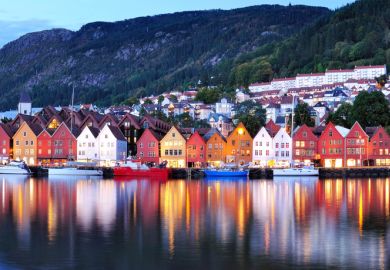Norwegian students will not benefit if their international peers are put off by tuition fees, sector leaders have said, with fears instead that unique programmes could wither away.
Universities and students were dismayed by the Labour-Centre coalition’s 2023 budget, which introduced tuition fees for students from outside the European Economic Area (EEA) or Switzerland.
The Ministry of Education and Research said resources would be freed up by huge drops in non-EEA intakes of about 70 per cent, as seen after similar moves in Denmark, Sweden and Finland, adding that international students who did come would generate income.
But the change is controversial in a sector that prides itself on educating students from the Global South.
“I was approached by a student from Bangladesh who was about to finish his master’s degree in global health, and he was very happy that he could take this education,” said Anne Borg, the rector of the Norwegian University of Science and Technology (NTNU). “We will not be able to offer studies for some of these people.”
NTNU has a master’s in hydropower engineering that is geared towards international students, a unique, 50-year-old offering that has educated students from some of the world’s poorest countries, plus a similar programme covering ecological urban planning, developed in partnership with India.
NTNU is still working through the implications of its 2023 budget, which foresees that 30 per cent of students will pay fees, but Professor Borg said there was a question “if the programmes themselves are sustainable. We will have to see what we do in the long run.”
Professor Borg said the claim that universities would earn an extra NKr900 million (£76 million) from the reforms was misleading and heavily dependent on enrolments. “This money is in the system already, so it’s more a question will we be able to fill these programmes with the number of students, or do we have to transfer and add more students to other programmes,” she said.
André Bryntesson, a research coordinator at the Swedish Centre for Studies of the Internationalisation of Higher Education at Uppsala University, said the Swedish experience of introducing fees showed that international students studied fields and at levels that were not as attractive to Swedish and European Union students, such as master’s level science courses. “It is not likely that those study places can be filled with students from Norway and the EU/EEA,” he said.
Klaus Mohn, rector of the University of Stavanger, said his institution had about 750 students on two-year master’s programmes, with more than 90 per cent coming from “middle- or low-income countries outside Europe, with very limited ability to mobilise funding for the required fees”.
“We are therefore convinced that the government’s estimate for a loss of 70 per cent of current students is too modest, and expect both the loss of students and the financial loss to exceed government estimates,” he said.
And Amine Fquihi, president of the International Students’ Union of Norway, said international students who could pay might still be put off. “The introduction of fees carries with it a nasty undertone of exclusion. Why pay for that?” he said.
The loss of international students would also narrow classroom discussions on global challenges, said Maika Godal Dam, head of the Norwegian Students Organisation, which plans nationwide protests against the fees on 26 October.
“When we do not get those perspectives, we will not have the same discussions around how we can deal with bigger international problems, such as education for all, climate change, questions of war and peace,” she said.
Register to continue
Why register?
- Registration is free and only takes a moment
- Once registered, you can read 3 articles a month
- Sign up for our newsletter
Subscribe
Or subscribe for unlimited access to:
- Unlimited access to news, views, insights & reviews
- Digital editions
- Digital access to THE’s university and college rankings analysis
Already registered or a current subscriber?








